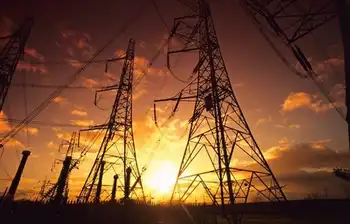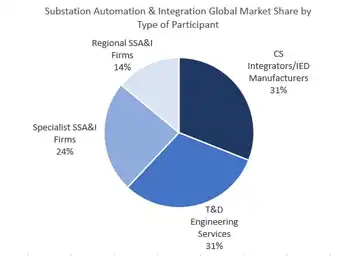ICT Electricity Demand is surging as data centers, 5G, IoT, and server farms expand, straining grids, boosting carbon emissions, and challenging climate targets unless efficiency, renewable energy, and smarter cooling dramatically improve.
Key Points
ICT electricity demand is power used by networks, devices, and data centers across the global communications sector.
✅ Projected to reach up to 20 percent of global electricity by 2025
✅ Driven by data centers, 5G traffic, IoT, and high-res streaming
✅ Mitigation: efficiency, renewable PPAs, advanced cooling, workload shifts
The communications industry could use 20% of all the world’s electricity by 2025, hampering attempts to meet climate change targets, even as countries like New Zealand's electrification plans seek broader decarbonization, and straining grids as demand by power-hungry server farms storing digital data from billions of smartphones, tablets and internet-connected devices grows exponentially.
The industry has long argued that it can considerably reduce carbon emissions by increasing efficiency and reducing waste, but academics are challenging industry assumptions. A new paper, due to be published by US researchers later this month, will forecast that information and communications technology could create up to 3.5% of global emissions by 2020 – surpassing aviation and shipping – and up to 14% 2040, around the same proportion as the US today.
Global computing power demand from internet-connected devices, high resolution video streaming, emails, surveillance cameras and a new generation of smart TVs is increasing 20% a year, consuming roughly 3-5% of the world’s electricity in 2015, says Swedish researcher Anders Andrae.
In an update o a 2016 peer-reviewed study, Andrae found that without dramatic increases in efficiency, the ICT industry could use 20% of all electricity and emit up to 5.5% of the world’s carbon emissions by 2025. This would be more than any country, except China, India and the USA, where China's data center electricity use is drawing scrutiny.
He expects industry power demand to increase from 200-300 terawatt hours (TWh) of electricity a year now, to 1,200 or even 3,000TWh by 2025. Data centres on their own could produce 1.9 gigatonnes (Gt) (or 3.2% of the global total) of carbon emissions, he says.
“The situation is alarming,” said Andrae, who works for the Chinese communications technology firm Huawei. “We have a tsunami of data approaching. Everything which can be is being digitalised. It is a perfect storm. 5G [the fifth generation of mobile technology] is coming, IP [internet protocol] traffic is much higher than estimated, and all cars and machines, robots and artificial intelligence are being digitalised, producing huge amounts of data which is stored in data centres.”
US researchers expect power consumption to triple in the next five years as one billion more people come online in developing countries, and the “internet of things” (IoT), driverless cars, robots, video surveillance and artificial intelligence grows exponentially in rich countries.
The industry has encouraged the idea that the digital transformation of economies and large-scale energy efficiencies will slash global emissions by 20% or more, but the scale and speed of the revolution has been a surprise.
Global internet traffic will increase nearly threefold in the next five years says the latest Cisco Visual Networking Index, a leading industry tracker of internet use.
“More than one billion new internet users are expected, growing from three billion in 2015 to 4.1bn by 2020. Over the next five years global IP networks will support up to 10bn new devices and connections, increasing from 16.3bn in 2015 to 26bn by 2020,” says Cisco.
A 2016 Berkeley laboratory report for the US government estimated the country’s data centres, which held about 350m terabytes of data in 2015, could together need over 100TWh of electricity a year by 2020. This is the equivalent of about 10 large nuclear power stations.
Data centre capacity is also rocketing in Europe, where the EU's plan to double electricity use by 2050 could compound demand, and Asia with London, Frankfurt, Paris and Amsterdam expected to add nearly 200MW of consumption in 2017, or the power equivalent of a medium size power station.
“We are seeing massive growth of data centres in all regions. Trends that started in the US are now standard in Europe. Asia is taking off massively,” says Mitual Patel, head of EMEA data centre research at global investment firm CBRE.
“The volume of data being handled by such centres is growing at unprecedented rates. They are seen as a key element in the next stage of growth for the ICT industry”, says Peter Corcoran, a researcher at the university of Ireland, Galway.
Using renewable energy sounds good but no one else benefits from what will be generated, and it skews national attempts to reduce emissions
Ireland, which with Denmark is becoming a data base for the world’s biggest tech companies, has 350MW connected to data centres but this is expected to triple to over 1,000MW, or the equivalent of a nuclear power station size plant, in the next five years.
Permission has been given for a further 550MW to be connected and 750MW more is in the pipeline, says Eirgrid, the country’s main grid operator.
“If all enquiries connect, the data centre load could account for 20% of Ireland’s peak demand,” says Eirgrid in its All-Island Generation Capacity Statement 2017-2026 report.
The data will be stored in vast new one million square feet or larger “hyper-scale” server farms, which companies are now building. The scale of these farms is huge; a single $1bn Apple data centre planned for Athenry in Co Galway, expects to eventually use 300MW of electricity, or over 8% of the national capacity and more than the daily entire usage of Dublin. It will require 144 large diesel generators as back up for when the wind does not blow.
Facebook’s Lulea data centre in Sweden, located on the edge of the Arctic circle, uses outside air for cooling rather than air conditioning and runs on hydroelectic power generated on the nearby Lule River. Photograph: David Levene for the Guardian
Pressed by Greenpeace and other environment groups, large tech companies with a public face , including Google, Facebook, Apple, Intel and Amazon, have promised to use renewable energy to power data centres. In most cases they are buying it off grid but some are planning to build solar and wind farms close to their centres.
Greenpeace IT analyst Gary Cook says only about 20% of the electricity used in the world’s data centres is so far renewable, with 80% of the power still coming from fossil fuels.
“The good news is that some companies have certainly embraced their responsibility, and are moving quite aggressively to meet their rapid growth with renewable energy. Others are just growing aggressively,” he says.
Architect David Hughes, who has challenged Apple’s new centre in Ireland, says the government should not be taken in by the promises.
“Using renewable energy sounds good but no one else benefits from what will be generated, and it skews national attempts to reduce emissions. Data centres … have eaten into any progress we made to achieving Ireland’s 40% carbon emissions reduction target. They are just adding to demand and reducing our percentage. They are getting a free ride at the Irish citizens’ expense,” says Hughes.
Eirgrid estimates indicate that by 2025, one in every 3kWh generated in Ireland could be going to a data centre, he added. “We have sleepwalked our way into a 10% increase in electricity consumption.”
Fossil fuel plants may have to be kept open longer to power other parts of the country, and manage issues like SF6 use in electrical equipment, and the costs will fall on the consumer, he says. “We will have to upgrade our grid and build more power generation both wind and backup generation for when the wind isn’t there and this all goes onto people’s bills.”
Under a best case scenario, says Andrae, there will be massive continuous improvements of power saving, as the global energy transition gathers pace, renewable energy will become the norm and the explosive growth in demand for data will slow.
But equally, he says, demand could continue to rise dramatically if the industry keeps growing at 20% a year, driverless cars each with dozens of embedded sensors, and cypto-currencies like Bitcoin which need vast amounts of computer power become mainstream.
“There is a real risk that it all gets out of control. Policy makers need to keep a close eye on this,” says Andrae.
Related News












